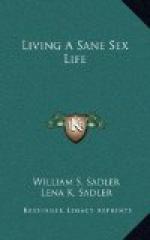The testicles are two kidney shaped glands, not far from the size of a large hickory nut, and are contained in a sort of sack, or pocket, called the scrotum, which is made for their comfortable and safe carrying. The scrotum hangs directly between the thighs, at the base of the penis, and in it are the testicles, suspended by vital cords that are suspended from the body above. The left testicle hangs a little higher in the sack than the right, so that, in case the thighs are crowded together, one testicle will slip over the other, and so the danger of crushing them will be avoided. This is one of the many ways which the Maker of the human body has devised to insure the proper preservation of the vital organs from harm, a fact which should inspire all human beings with profound reverence for this most wonderful of all life forms, the beautiful human body, the “temple of the Holy Spirit.”
The part of the body upon which the sex organs, male and female, are located is known as the pubic region. It is covered with hair, which, in both sexes, extends well up the lower belly. This is known as pubic hair, and in general corresponds in quality and quantity to the hair upon the individual head, being coarse or fine, soft or bristly, to match, the head covering, in each case. This hair is usually more or less curly, and forms a covering an inch or more in depth over the whole pubic region, extending back between the thighs slightly beyond the rectum. In occasional cases this hair is straight and silky, and sometimes grows to great length, instances being known, in some women, where it has extended to the knees. A well-grown and abundant supply of fine pubic hair is a possession highly prized by women, of which they are justly proud, though few of them would acknowledge the fact, even to themselves. None the less it is a fact.
The female sex organs, speaking generally also, are as follows: The vulva, or outward portion of the parts; the vaginal passage; the uterus, or womb, and the ovaries. All but the first named lie within the body of the woman. The vulva is made up of several parts which will be named and described later. The vaginal passage is a tube, or canal leading from the vulva to the womb. In length and diameter it corresponds almost exactly with that of the penis, being six or seven inches in depth, and capable of a lateral extension which will readily admit the entrance of the male organ when the two are brought together. The vaginal passage opens into, and terminates in the uterine, or womb cavity.
The womb is a pear shaped sack which is suspended in the womb cavity by cords and muscles from above. It hangs, neck downwards, and is, in its unimpregnated condition, about two and a half inches in diameter at its upper, or widest part, tapering to a thin neck at its lower end. It is hard and muscular in its quiescent state, filled with delicate and most sensitive nerves and capacious blood vessels. At its lower, or neck end, it opens directly into the vaginal passage.




